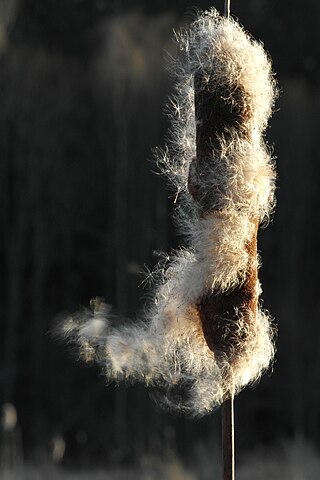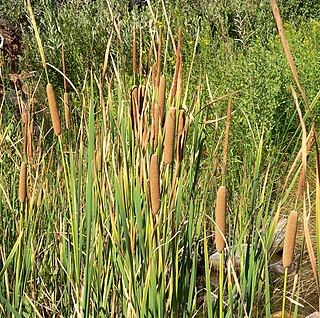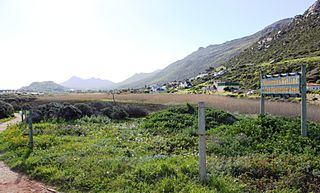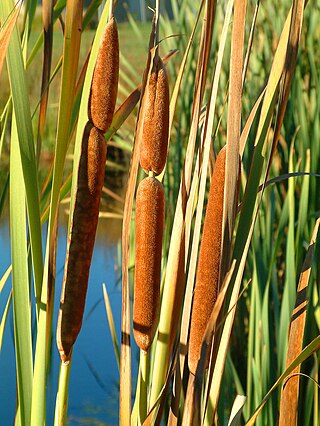
Typha is a genus of about 30 species of monocotyledonous flowering plants in the family Typhaceae. These plants have a variety of common names, in British English as bulrush or reedmace, in American English as cattail, or punks, in Australia as cumbungi or bulrush, in Canada as bulrush or cattail, and in New Zealand as reed, cattail, bulrush or raupo. Other taxa of plants may be known as bulrush, including some sedges in Scirpus and related genera.

A reedbed or reed bed is a natural habitat found in floodplains, waterlogged depressions and estuaries. Reedbeds are part of a succession from young reeds colonising open water or wet ground through a gradation of increasingly dry ground. As reedbeds age, they build up a considerable litter layer that eventually rises above the water level and that ultimately provides opportunities in the form of new areas for larger terrestrial plants such as shrubs and trees to colonise.

Typha latifolia is a perennial herbaceous wetland plant in the genus Typha. It is known in English as bulrush, and in American as broadleaf cattail. It is found as a native plant species throughout most of Eurasia and North America, and more locally in Africa and South America. The genome of T. latifolia was published in 2022.
Aegilops juvenalis is a species in the family Poaceae.

Typha angustifolia is a perennial herbaceous plant in the genus Typha, native throughout most of Eurasia and locally in northwest Africa; it also occurs widely in North America, where its native status is disputed. It is an "obligate wetland" species that is found in fresh water or brackish locations. It is known in English as lesser bulrush, and in American as narrowleaf cattail.

Calamotropha paludella is a species of moth of the family Crambidae. It is found in Europe, Africa, Australia and large parts of Asia.
Melieria turcomanica is a species of ulidiid or picture-winged fly in the genus Melieria of the family Ulidiidae.
Microcephala is a genus of Asian flowering plants in the chamomile tribe within the daisy family.

Typha domingensis, known commonly as southern cattail or cumbungi, is a perennial herbaceous plant of the genus Typha.

The bulrush wainscot is a moth of the family Noctuidae. It is found from Ireland and Portugal to southern Fennoscandia, east to western Siberia, the Altai Mountains, Yakutia, Turkey, the Caucasus, Lebanon, Egypt, Arabia, Iraq, Iran, Afghanistan and Central Asia.

Lower Silvermine Wetlands is a nature reserve on the Cape Peninsula, in Cape Town, South Africa.

Typha minima, common name dwarf bulrush or miniature cattail or least bulrush, is a perennial herbaceous plant belonging to the Typhaceae family.

Typha orientalis, commonly known as bulrush, cumbungi, or raupō, is a perennial herbaceous plant in the genus Typha. It is native to Australia, New Zealand, Malaysia, Indonesia, Japan, Korea, Mongolia, Myanmar, Philippines, China and the Russian Far East.

Typha capensis is an aquatic plant known from southern and eastern Africa as far north as Uganda. It has also been reported from Brazil.
Typha shuttleworthii is a species of cattail found in southern Europe as well as in Iran and Turkey.
Typha caspica is a plant species native to Republic of Azerbaijan between Russia and Iran. The species grows in freshwater marshes.
Typha grossheimii is a plant species native to Iran, Iraq, Uzbekistan, Afghanistan, Kazakhstan, Kyrgyzstan, Azerbaijan, Armenia, and the Republic of Georgia.

Mandragora is a plant genus belonging to the nightshade family (Solanaceae). Members of the genus are known as mandrakes. Between three and five species are placed in the genus. The one or two species found around the Mediterranean constitute the mandrake of ancient writers such as Dioscorides. Two or three further species are found eastwards into China. All are perennial herbaceous plants, with large tap roots and leaves in the form of a rosette. Individual flowers are bell-shaped, whitish through to violet, and followed by yellow or orange berries.
Mandragora turcomanica, the Turkmenian mandrake, is a perennial herbaceous plant in the family Solanaceae, native to the Köpet Dag mountains in Turkmenistan and one location in neighbouring Iran. It differs from the mandrakes found around the Mediterranean chiefly by being larger.

Typha × glauca is a hybrid species of plant originating as a cross between T. angustifolia and T. latifolia. It shows invasive behavior in the Midwestern United States












